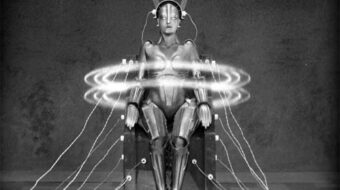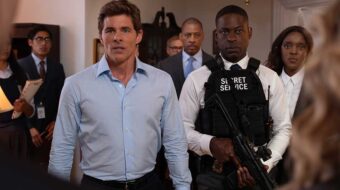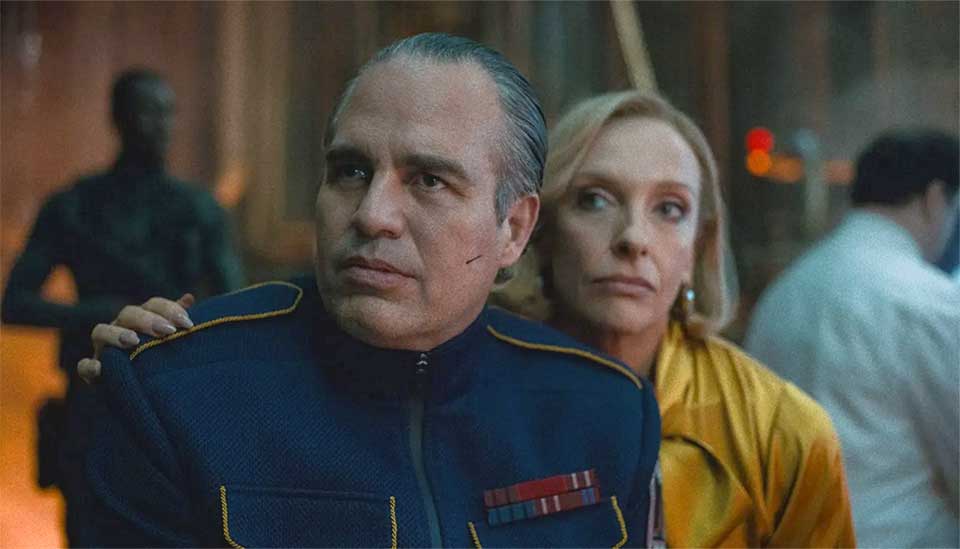
I walked into a packed theater for the opening weekend of Bong Joon Ho’s latest film, Mickey 17. It was Gateway Film Center’s largest theater, one that I hadn’t seen that full since the premiere of one of the Spider-Man movies involving “the multiverse,” that perverted cash grab of a shtick that I’m happy to see fade away. I sat down just in time for the opening scene, preserving my free movie popcorn for the film itself (as opposed to finishing it during the previews). It was a good omen, and I thought the film delivered. It was only when I started researching for this article that I realized I was in the minority.
Mickey 17 is Bong Joon Ho’s latest sci-fi film. Based on Edward Ashton’s novel Mickey7, the main character, Mickey Barnes (Robert Pattinson), is the “expendable” worker on a colonization mission to an icy exoplanet. An “expendable” is a worker whose memory and body scans are stored on a drive and uploaded to a massive 3D printer that reprints the individual every time he dies. Due to political and ethical concerns about the process, it’s banned on Earth and only allowed for one crew member on the expedition. Problems arise when a new Mickey is printed, Mickey 18, but his past iteration, Mickey 17, survives a brush with the native animals called “creepers,” who we assume would’ve eaten him. As the expedition’s dictatorial leader, Kenneth Marshall (Mark Ruffalo) threatens to exterminate the “creepers,” the Mickeys and their girlfriend Nasha (Naomie Ackie) try to save the species and themselves.
Bong is one of the few directors working today whose works would’ve once been called “proletarian culture,” that is, culture centering and championing working-class subjects (Grapes of Wrath, Native Son, Jews Without Money) as opposed to “bourgeois culture” (more recently Succession, Wolf of Wall Street, The Great Gatsby movie, etc.) His Oscar-winning 2019 movie Parasite showed a working-class Korean family driven to insanity while working at a rich family’s home. In his 2013 film Snowpiercer, an apocalyptic society lives on a train where each class is divided by car. Mickey 17 doesn’t stray from working-class subjects, in this case a man who’s endlessly killed for his job, a job he only got to avoid being slowly killed by a loan shark, but neither side of the political spectrum is particularly fond of the movie, which they see as being too long and predictable.
In Dubious Battle (2016)
Right-wing writer Alan Ng argued that the film lacked depth. In reference to Marshall’s similarities to Trump, Ng said that the character is “just a guy who’s insane and a dictator. There’s no nuance to it. There’s nothing to it other than that we’re supposed to hate the guy.” As we’ll see later, it could be Ng’s shallow understanding of Marshall that colors his view of the character and the plot.
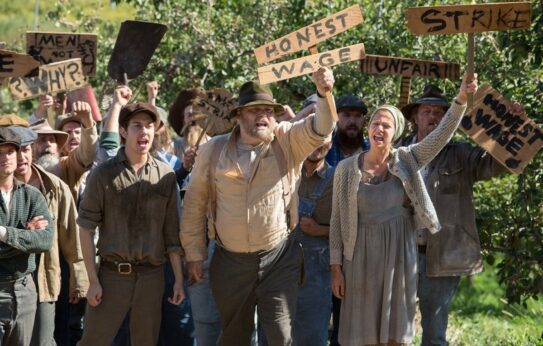
The response from the left-wing publication Jacobin was similar. Film critic Eileen Jones writes that “[a]fter a fairly energetic start, Mickey 17 drags along like a dying animal, leaking vitality all the way.” While sympathizing with the politics, Jones thought that Bong “steered this ship slowly off course.”
I found myself at odds with both takes here. Maybe it was because I felt the film was less about the aesthetics of the dictator or the act of class struggle—in fact, there is little collective action outside of the two Mickeys and Nasha—and more about something else. It seemed apparent to me pretty early on, with popcorn still remaining in my soggy popcorn bag, that if there’s a struggle playing out through the film, it’s a political struggle between the dictator Marshall and the congress. Although it was Mickey 18 who killed the dictator, it was the security guards acting on behalf of the congress that banded together to stop him and his wife. The story poses a rather timely question: can parliamentary democracies stop fascism? The answer, at least on the planet of Niflheim, is decisive.
Class wars
How did Mickey end up in a suicidal role like this? He admits pretty blatantly that it was Timo’s fault for convincing him to start a macaron business with loans from the mob. It was an attempt at class mobility that is possible, but not always smooth, under capitalism. This was outlined in Marx’s Communist Manifesto, Capital, and the Grundrisse, the first of which professed that:
“The lower strata of the middle class—the small tradespeople, shopkeepers, and retired tradesmen generally, the handicraftsmen and peasants—all these sink gradually into the proletariat, partly because their diminutive capital does not suffice for the scale on which Modern Industry is carried on, and is swamped in the competition with the large capitalists, partly because their specialized skill is rendered worthless by new methods of production.”
While the 19th century saw shopkeepers swept into the factory, workers today find themselves swept out of the factory and into monopoly service and retail companies like Walmart and Amazon. Mickey had a different trajectory, but his fate was determined by the same set of economic laws. As Mickey is used as a crash test dummy, being killed over and over again, then getting reprinted with his memories, his macaron partner, Timo, is respected as a pilot (and a drug dealer on the side).
He feels sorry for Mickey, but pictures himself as being closer to the owners than an expendable. (Which is, of course, not true. I can’t help but find a parallel with today’s pilots who are generally, in my experience, politically conservative—it was the militant flight attendants, however, who voted 99.9% in favor of a strike in 2024.) While Bong maintains the film as “a story about working-class people,” it’s not entirely clear who the owners are on the ship. We, as the audience, only see Marshall, security, and the scientists who experiment on Mickey. The struggles that unfold in the film appear less to do with class per se and more to do with the political struggle between Marshall and Congress. There is, however, one grossly overlooked character.
Stopping space fascism
Throughout the film, a bald individual with a swastika-esque logo on his person is constantly whispering in Marshall’s ear. It becomes apparent that Marshall is not the one calling the shots, but is instead a mere puppet of the ominous bald man. The shiny man is not acting as a rogue individual, however, but a representative of what’s called “the church,” although a rebuttal always follows the name clarifying that it’s “the company,” or vice versa. Marshall takes his advice like scripture.
The puppetry is not dissimilar from the structure of fascism in the 20th century. Illuminated most clearly in America’s “Business Plot,” the attempted overthrow of FDR led by a handful of America’s most reactionary industrialists, fascism only comes to power after securing the backing of a number of big industrialists.
At first, this appears to be out of convenience—someone has to buy all of those fancy uniforms for the big marches after all—but the balance eventually shifts. The early backer of the Nazis Fritz Thyssen was so instrumental that one journalist wrote in 1933 that “The National Socialist Government of Germany today carries out Thyssen’s policy on all matters, as though the entire nation were but a part of the Steel Trust.”
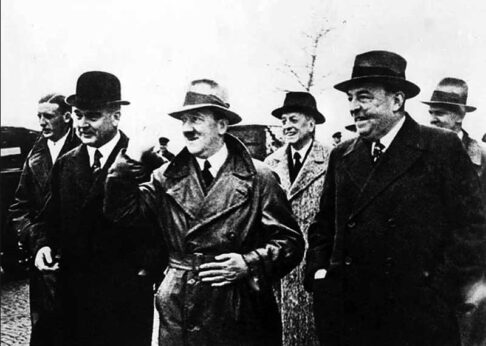
In the film, it is clear that Marshall, not unlike fascist parties historically, cannot overthrow democracy overnight. It is a process, an ascension, and the two sides—bourgeois democracy and fascism—have to duel it out. (Even after the fascists secure power, they have to engage in a prolonged struggle to dismantle the democratic state apparatus.)
At the conclusion of the film, it’s bourgeois democracy that wins. But it is not solely through legal means that Congress succeeds. Mickey 18 sacrifices himself to kill the dictator, and the security forces take the side of Congress. The victory is seen as conclusive. Congress wins, and the colony co-exists with the native “creepers.”
The viewer is at ease by the end of the film, but the reality of history is more complex. Fascistic characteristics are always present within capitalism, the ideology was not in itself an entirely new system: The Nazis found inspiration from American segregation after all. The threat is always there, even if bourgeois democracy wins, such is the nature of monopoly capitalism.
The message of the film is ultimately utopian: that it’s possible to defeat fascism permanently under capitalism. I understood that this was a fanciful message, but one that could’ve been open-ended. I could imagine the bald man coming back and finding a new dictator. But the only thing more utopian than believing the fascist threat is subdued at the end of the movie is believing that there isn’t a fascist threat at all, a problem that plagues all sides of the political spectrum today.
In this reviewer’s opinion, liberals, early on, had no problem casually calling Trump a fascist, but many on the Left, believing the term “fascist” carried specific historic conditions that Trump had not yet met, desisted from using the word or debating the topic. It certainly does seem appropriate by now. As the steps towards dictatorship laid out in Project 2025 are implemented, one has to ask where Congress and the Mickeys are to save the day, even if temporarily. The irony is that it will take class struggle to defeat it. The long-term solution is obvious. As the saying goes, socialism or extinction.
Reposted from Substack with minor changes conforming to PW style.



